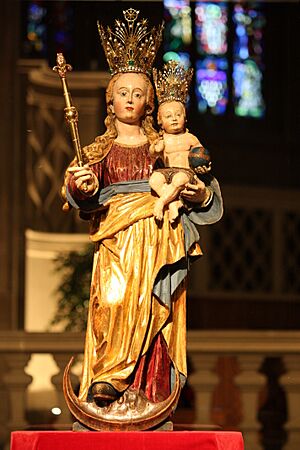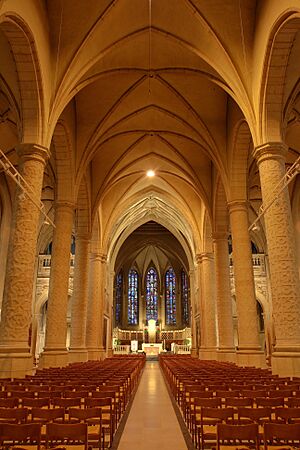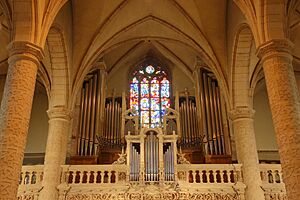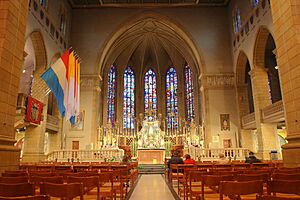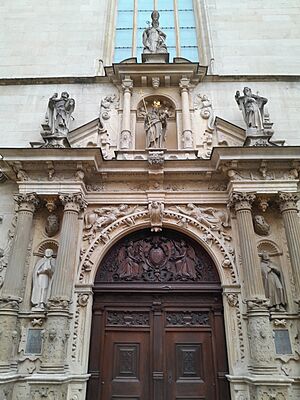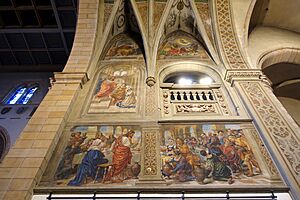Notre-Dame Cathedral, Luxembourg facts for kids
Quick facts for kids Cathedral of Our Lady of Consolation of LuxembourgKathedral Notre-Dame Cathédrale Notre-Dame Kathedrale unserer lieben Frau |
|
|---|---|
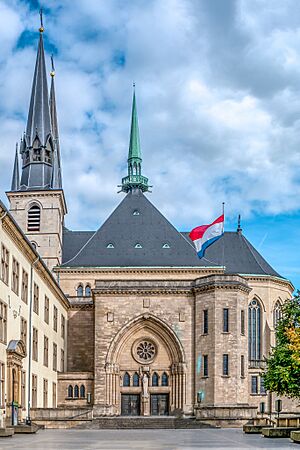
Our Lady of Luxembourg
|
|
| Religion | |
| Affiliation | Catholic Church |
| Province | Archdiocese of Luxembourg |
| Ecclesiastical or organizational status | Cathedral |
| Status | Active |
| Location | |
| Location | Luxembourg City, Luxembourg |
| Architecture | |
| Architectural type | Church |
| Architectural style |
|
| Groundbreaking | 1613 |
| Completed | 1938 |
The Notre Dame Cathedral is a beautiful Catholic church in Luxembourg City, the capital of Luxembourg. It is the only cathedral in the country. A cathedral is the main church of a bishop's area.
This impressive building started as a church for the Jesuits, a group of Catholic priests. Its first stone was placed in 1613. The cathedral shows off a mix of old styles. It has many features of late Gothic architecture, which is known for its tall spires and pointed arches. It also includes elements from the Renaissance period, which brought back ideas from ancient Greece and Rome.
In 1866, Pope Pius IX honored a special statue of Our Lady of Consolation. This statue is important because she is seen as the protector of both Luxembourg City and the whole country. The church was officially named the Church of Our Lady in 1870. Later that same year, it became the Notre-Dame Cathedral.
Near the cathedral, there is a monument called the National Monument to the Resistance and to the Deportation. It honors people who resisted during difficult times. A famous bronze statue called The Political Prisoner is part of this monument. The cathedral itself was made bigger between 1935 and 1938.
Contents
History of the Cathedral
In 1603, Jesuit priests from Belgium opened a college in Luxembourg City. Many young people from Luxembourg studied there until 1773. The construction of their church began on May 7, 1613. Father François Aldenard oversaw the start of the project. Ulrich Job, from Lucerne, was the main builder. He also helped decorate the columns inside. The Jesuit church was officially opened on October 17, 1621. It was dedicated to the Immaculate Conception.
A German sculptor named Daniel Muller helped make the church beautiful. He created the organ tribune, which is where the organ sits. The decorations used alabaster, a soft stone. These decorations show early Baroque angels playing music among leaves and flowers.
After the Jesuits left in 1773, Empress Maria Theresa of Austria gave the church to Luxembourg City in 1778. It became the new local church and was called "Saint Nicolas et Sainte Thérèse." This was helpful because the old local church was small and falling apart. It was torn down in 1779. That is why a statue of Saint Nicholas is now above the cathedral's entrance. In 1801, the church was renamed and dedicated to Saint Peter.
On March 31, 1848, the church received the name "Notre-Dame." Later, in 1854, its inside was updated to a neo-Gothic style. When Luxembourg became a bishopric (an area led by a bishop) in 1870, the Notre-Dame Church officially became the Notre-Dame Cathedral.
Cathedral Architecture
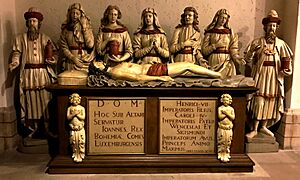
The Notre Dame Cathedral is a great example of late Gothic architecture. However, it also has many features and decorations from the Renaissance period. This mix of styles makes it unique.
Enlargement in the 20th Century
The cathedral was made larger between 1935 and 1938. This expansion changed the look of Luxembourg City. The architect, Hubert Schumacher, made sure the new parts blended well with the old church. He also made sure it fit in with nearby historic buildings. These included the old Athénée building and the national library.
The Cathedral Towers
The cathedral has three towers. The west tower was part of the original Jesuit church. It holds the church bells. The east tower and the central tower were added when the cathedral was enlarged from 1935 to 1938.
The central tower is shorter than the others. It has a wide, pyramid-shaped base and a narrow top covered with copper. On April 5, 1985, the west tower caught fire during roof work. The church bells were destroyed in the fire. These bells included the Virgin Mary bell, the Willibrord bell, the Peter bell, and the Cunigunde bell. The tower was repaired by October 17, 1985.
Burials in the Crypt
The crypt is an underground room in the cathedral. It is the resting place for many important people from Luxembourg's royal family. These include Grand Dukes and Grand Duchesses.
Some of the people buried here are:
- John of Bohemia (1296–1346), whose remains were moved here in 1945.
- Marie-Adélaïde, Grand Duchess of Luxembourg (1894–1924)
- Marie Anne, Grand Duchess of Luxembourg (1861–1942)
- Felix, Prince Consort of Luxembourg (1893–1970)
- Prince Charles (1927–1977)
- Charlotte, Grand Duchess of Luxembourg (1896–1985)
- Joséphine Charlotte, Grand Duchess of Luxembourg (1927–2005)
- Jean, Grand Duke of Luxembourg (1921–2019)
See also
 In Spanish: Catedral de Nuestra Señora (Luxemburgo) para niños
In Spanish: Catedral de Nuestra Señora (Luxemburgo) para niños
- Roman Catholic Marian churches
- List of Archbishops of Luxembourg
- List of Jesuit sites


